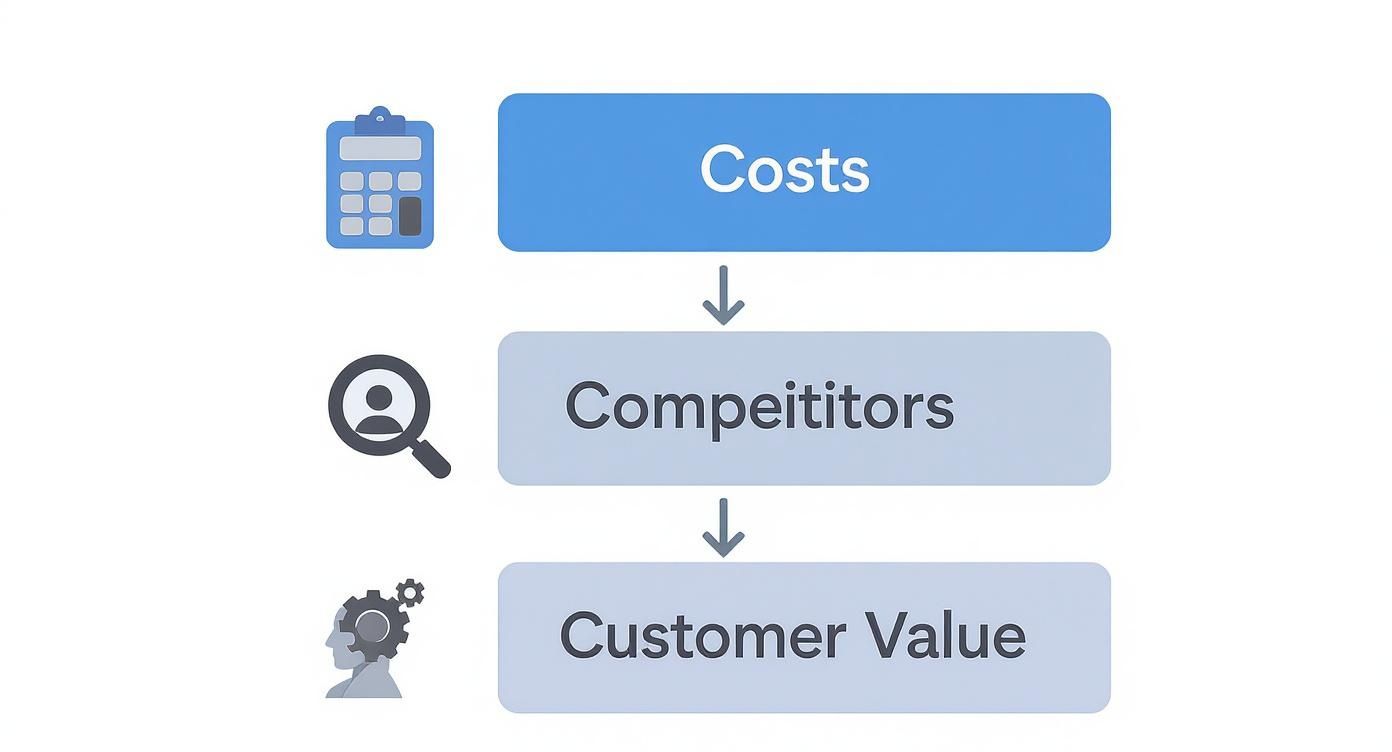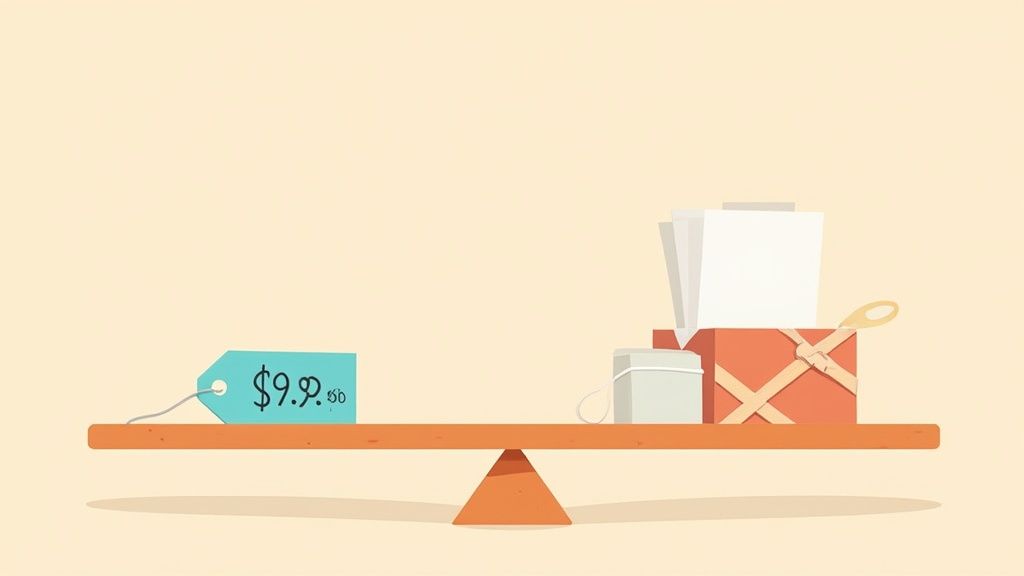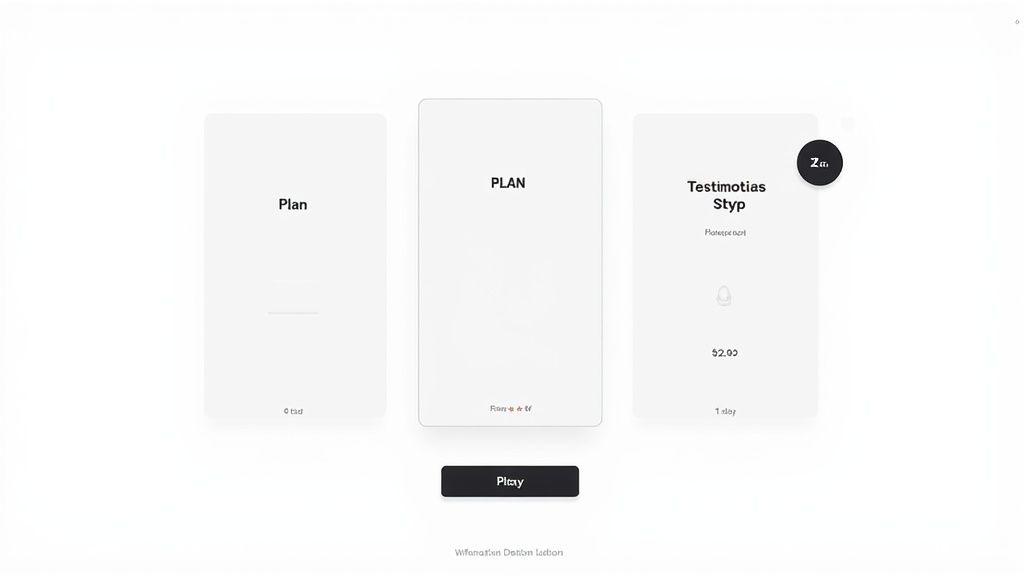A Smart Pricing Strategy for Small Business Growth

A solid pricing strategy for a small business is about so much more than just covering your costs. It's about knowing your numbers, sure, but it’s also about understanding your market and what your customers truly value. When you nail this, you move from just surviving to strategically positioning yourself for real, sustainable growth.
Building a Price Point That Actually Works
Pricing can feel like you're just guessing, but it really doesn't have to be a shot in the dark. For small business owners, an effective strategy starts way before you ever pick a number. It all begins with a brutally honest look at what it actually costs to deliver your product or service.
So many founders fall into the trap of only counting the obvious stuff, like materials or that new software subscription. But the real profit killers? They're the hidden costs that creep up on you—things like marketing spend, payment processing fees, and, yes, the value of your own time. Getting a handle on every single one of these is your first step toward a price that actually makes you money.
Calculating Your True Business Costs
To get the real picture, you have to track everything. And I mean everything. It’s not just about the big-ticket items; it’s every little thing that keeps your business running. Think software tools, bank fees, insurance, even a slice of your utility bills if you’re working from home.
To make this less of a headache, I’d seriously consider using dedicated accounting software. Tools like Xero, for example, are built specifically for small businesses to track what’s coming in and what’s going out. It gives you a live look at your financial health, which is absolutely crucial for making smart pricing moves.
Just look at this dashboard from Xero's website. It gives you a clean, simple overview of cash flow and what's in your accounts.
When you can see your financials laid out like this, it’s much easier to spot trends and make sure your pricing covers all your costs, not just the ones you remember off the top of your head.
Analyzing Competitor Pricing
Once you’ve got your costs locked down, it’s time to see what everyone else is doing. The point here isn't to just copy their prices—it's to understand the lay of the land. A bit of digging will show you what your direct and indirect competitors are charging for similar stuff.
Pay close attention to how they're structuring their pricing.
- Are they using tiered packages? That could signal they're targeting different types of customers with different needs.
- Is it a one-time purchase or a subscription? This tells you a lot about their business model and how they think about customer relationships.
- What features do you get at each price point? This is gold. It shows you how they're communicating value to their customers.
This kind of analysis helps you spot the gaps. Maybe everyone is chasing the high-end clients, leaving a wide-open opportunity for a more accessible option. Or maybe they’re all in a race to the bottom on price, which means you can stand out by offering a premium, value-packed service.
Key Takeaway: Looking at your competitors isn't about matching what they do. It’s about finding your own lane. Use what you learn to make your offer different and justify a price based on the unique value you bring to the table.
Understanding Perceived Customer Value
Now for the most important piece of the puzzle: what your customers actually think your product is worth. This number is often completely disconnected from your costs. A customer doesn't care about your overhead; they care about the problem you solve for them.
How much time are you saving them? How much money are you helping them make? How much stress are you taking off their plate? Putting a number on that value is the secret to pricing with confidence. Research has shown that smart pricing strategies can boost returns on every single sale by 2-7%. That's a direct result of linking your price to the value customers perceive. If you want to dive deeper, you can learn more about how to execute a competitive pricing strategy and see the data yourself.
This is it. Shifting from "what does this cost me?" to "what is this worth to them?" is the single most powerful change you can make to your pricing.
Finding the Right Pricing Model for Your Business
Alright, you've done the hard work. You have a solid grasp of your costs, what your competitors are up to, and what your customers truly value. Now it’s time to turn all that research into an actual price tag by choosing a pricing model.
Think of a model as the strategic framework for your price. This isn't a one-size-fits-all decision; the right one will feel like a natural extension of your product, your customers, and where you want to take your business.
This visual decision tree is a great starting point for figuring out where to focus first.

It’s a simple reminder that your pricing strategy rests on three pillars: what it costs you (internal), what the market will bear (external), and what your customers believe it's worth (perception). Get those three aligned, and you're golden.
Let's break down the three most common models you'll encounter. Each has its place, but one will likely be a much better fit for your specific business.
To give you a quick overview, here's how the big three stack up against each other.
Comparison of Common Small Business Pricing Models
| Pricing Model | How It Works | Pros | Cons | Best For |
|---|---|---|---|---|
| Cost-Plus | Calculate total costs, then add a fixed markup percentage. | Simple to calculate, guarantees a profit on each sale, predictable. | Ignores customer value and market competition, might leave money on the table. | Physical products, retail, manufacturing, or simple services with clear costs. |
| Value-Based | Price is based on the perceived value delivered to the customer. | Higher profit margins, aligns your success with the customer's, strong positioning. | Harder to quantify value, requires deep customer research and confidence. | Consulting, specialized software, expert services, high-impact B2B solutions. |
| Tiered | Offer multiple packages at different price points with varying features. | Caters to different customer segments, creates an upgrade path, simplifies the buying decision. | Can be complex to set up, requires balancing features across tiers. | SaaS, agencies, service-based businesses, and digital products. |
Choosing the right model is about finding the one that best reflects how your business creates value. Don't just default to the easiest one; think about which model will support your growth in the long run.
The Simplicity of Cost-Plus Pricing
The most straightforward model on the block is cost-plus pricing. It’s exactly what it sounds like: figure out your total cost to produce and deliver your product or service, then add a standard markup. Done.
If you make handmade leather wallets and your total cost for materials, labor, and overhead is $40, a 50% markup means you sell it for $60. It's simple, guarantees you cover your expenses, and gives you a predictable profit on every single sale. This is a solid starting point for businesses with tangible goods or clear-cut services.
The big catch? It completely ignores your customer and the market. You could be leaving a ton of money on the table if customers are happy to pay more. Or worse, you might price yourself out of the game entirely if your costs are too high compared to competitors.
The Customer-Centric Approach of Value-Based Pricing
On the opposite end of the spectrum is value-based pricing. This model anchors your price not to your costs, but to the perceived value you deliver. It's all about what the result is worth to your customer.
Think about a consultant who helps a client land a $10,000 contract. Charging $2,000 has nothing to do with the hours they worked; it's based on the massive value they created. This approach almost always leads to higher profit margins because you’re capturing a piece of the success you generate for your clients.
Value-based pricing is powerful because it forces you to focus on what matters most—solving customer problems. When you can clearly articulate the value you provide, customers are far more willing to pay a premium for it.
The main challenge is actually putting a number on that value. It takes more research, more confidence, and a deep understanding of your customer’s pain points. But when you get it right, the payoff is huge.
The Flexibility of Tiered Pricing
For many software companies and service providers, tiered pricing offers the best of both worlds. This model involves creating several different packages or "tiers" at different price points, each offering a distinct level of features, access, or support.
This strategy is incredibly effective for a few reasons:
- It hits multiple customer segments. A tiny startup can get in on your basic plan, while an enterprise client can spring for the premium tier with all the bells and whistles.
- It builds a clear upgrade path. As a customer's business grows, they naturally move up your tiers, increasing their lifetime value without you having to re-sell them.
- It makes buying easier. Instead of a single "take-it-or-leave-it" price, you give people options. This helps them find a fit for their specific needs and budget.
Tiered pricing has become the standard in the software world for a reason. Most SaaS companies offer an average of 3.5 tiers, which shows just how well this flexibility works to capture a broader market.
For service businesses like agencies, this often comes down to structuring your packages. A common question is whether to charge per lead or lock in a monthly retainer. If you're weighing those options, our deep-dive on which pricing model yields more stable MRR for lead gen agencies provides some valuable context for structuring your own tiers.
Using Smart Tactics to Boost Your Revenue
Okay, so you've landed on a core pricing model. That gets you in the game, but winning takes a bit more finesse. This is where experienced founders layer in specific psychological and strategic plays to make their pricing really work.
These aren't shady tricks. They're smart adjustments that tap into how customers actually think about value, and they can give your revenue a serious bump.

By layering these techniques onto your main strategy, you build a pricing structure that’s far more robust and profitable. Let's dig into a few of the most effective ones.
The Psychology of Pricing Numbers
Ever wonder why so many prices end in .99? It’s a classic move called charm pricing. Our brains have a funny quirk where we tend to anchor on the first digit we see. This makes $9.99 feel significantly cheaper than $10.00, even though we consciously know it’s only a one-cent difference. This "left-digit effect" is a powerful tool, especially for products where the perceived value is tied to a specific price point.
But then there's the flip side: prestige pricing. This is all about setting a higher price to signal superior quality, exclusivity, or luxury. A high-end consultant or a premium e-commerce brand on Shopify might deliberately avoid prices ending in .99. A round number like $500 just feels more deliberate and confident than $499, reinforcing the premium vibe of the offer.
So, which one is for you? It comes down to your brand positioning.
- Use Charm Pricing if you're competing on price or want to signal a great deal.
- Use Prestige Pricing if your brand is built on quality, deep expertise, and a top-tier customer experience.
Strategic Bundling and Unbundling
Another powerful lever is how you package your offerings. Bundling is when you combine several products or services into a single package, usually for a lower price than if someone bought each item on its own. It's a fantastic way to increase your average order value (AOV).
A freelance writer, for example, could bundle blog post creation, social media captions, and a monthly analytics report into one "Content Growth Package." This gives the client a more complete solution and locks in more predictable revenue for the writer. It simplifies the buying decision and can make a higher price point feel much more justified.
Key Insight: Bundling works best when the combined items solve a larger, more complete problem for the customer. The goal is to create a package that is more valuable than the sum of its parts.
Of course, the opposite strategy, unbundling, can be just as effective. This means breaking a large service down into smaller, individual components that can be bought separately. Unbundling creates more accessible entry points for customers who aren't ready for your full, high-ticket offer. A web designer could unbundle their all-in-one website package into standalone services like "Landing Page Design," "SEO Audit," or "Speed Optimization."
Simplified Dynamic and Promotional Pricing
You don't need a fancy algorithm to use dynamic pricing. For a small business, it can be as simple as adjusting your prices based on clear signals of demand.
An event photographer might charge more for a Saturday booking than a Tuesday. A vacation rental owner naturally adjusts rates for peak season versus the off-season. The key is to spot these predictable patterns in demand and price accordingly.
Similarly, promotional pricing—temporarily dropping prices to drive sales—is a go-to for a reason. It's perfect for e-commerce stores launching a new collection or service businesses trying to book out a slow month. It creates urgency and can pull in new customers who were on the fence.
A word of caution, though: use promotions strategically. Constant discounts can devalue your brand and train customers to just wait for a sale. Instead of random markdowns, tie your promotions to specific events like holidays, product launches, or an anniversary sale. This gives them context and protects the perceived value of your core offer.
How to Confidently Communicate Your Pricing
Nailing your pricing strategy is a huge win, but it's only half the job. Even the most perfect price will fall flat if you don't present it with confidence. Now, let's talk about how to communicate that price so customers not only understand it but feel great about their decision to buy.
Think of your pricing page as your best salesperson—one that works 24/7 without a coffee break. It needs to be clear, compelling, and trustworthy from the second someone lands on it. This is where you draw a straight line from your price tag to the real-world problems you solve.

This example from Leadpages shows how clean and professional a pricing section can look without touching a line of code. A simple, well-organized layout helps people instantly compare their options and see the value in each tier, which is absolutely critical for getting them to click "buy."
Designing a High-Converting Pricing Page
A great pricing page does way more than just list numbers; it tells a story of value and guides visitors to the best choice for them. You could use a tool like Webflow to build something completely custom, but the core principles are the same no matter what platform you're on.
Here’s what you need to nail:
- Clean, Simple Layouts: Put your plans side-by-side in a simple comparison table. This makes it dead simple for potential customers to see exactly what they get at each level.
- Highlight the Best Choice: Gently nudge people toward your preferred plan. You can do this with a subtle visual cue like a different color, a "Most Popular" banner, or by making that column slightly larger.
- Sprinkle in Social Proof: Nothing builds trust faster than seeing that other people have already found success with you. Add testimonials, customer logos, or mini case studies right on the page to squash any hesitation.
We’ve actually put together a deep dive on this. You can check out our breakdown of effective SaaS pricing page examples to see these ideas in action on real-world sites.
Framing Your Price for Maximum Impact
How you talk about your price can completely change how people perceive it. Instead of just stating the cost, frame it in terms of the return on investment (ROI) your customer will see. Don't sell a $500 service; sell the $5,000 in new business it's going to help them generate.
Another great psychological trick is price anchoring. If you show a more expensive option first—even one you don't expect many people to choose—it makes your other plans seem much more affordable by comparison. It’s a subtle but powerful way to make your target package look like a fantastic deal.
Key Takeaway: The conversation should never be about what your service costs. It should be about what it's worth to your customer. Always bring it back to the value, savings, or growth they'll get.
Educate Customers Before They Even See the Price
By the time someone lands on your pricing page, their decision to buy should already be mostly made. This is where smart, proactive communication—especially email—comes into play. When you educate potential customers on your value over time, you're warming them up for the sale long before they see a price tag.
Using an email marketing platform like Brevo, you can set up an automated email sequence that works for you in the background.
Have it do things like:
- Explain the problem you solve in a relatable way.
- Share customer success stories and case studies.
- Offer genuinely useful tips and insights related to their industry.
When they finally click over to your pricing, they already get it. They understand the value and trust your expertise. The price isn't a shocking hurdle; it's just the logical next step to solving their problem.
This strategy is a lifesaver for small businesses. Email marketing has one of the best returns out there, delivering around $44 for every $1 spent. That kind of ROI makes it an essential tool for any founder or small team trying to grow without a massive budget.
Keeping Your Pricing Strategy Sharp and Effective
Your pricing is not a "set it and forget it" decision you make once and then file away. The market is constantly in motion—your costs creep up, competitors make moves, and what your customers value today might not be what they value tomorrow.
A price that felt perfect six months ago could be the very thing holding you back now. Honestly, treating your price point as a static number is one of the biggest mistakes you can make.
Instead, think of your pricing as a living, breathing part of your business that needs regular check-ups. This doesn't mean you should be flip-flopping your prices every other Tuesday. It means creating a simple, repeatable system for testing ideas, listening to your customers, and making smart adjustments backed by real data, not just a gut feeling.
This builds a powerful feedback loop: make a small change, measure what happens, learn from it, and do it again. It's this iterative process that turns your pricing from a simple number into a sharp tool for growth.
Gathering Direct Customer Feedback
The quickest way to figure out if your pricing is hitting the mark is to just ask the people who are actually paying you. Your customers are sitting on a goldmine of insights, but you have to give them an easy way to share it. Forget clunky, multi-page surveys; simple, direct conversations are almost always better.
You can start pulling in this feedback in a few practical ways:
- Post-Purchase Surveys: Right after a customer makes a purchase, hit them with a single-question survey. Something as simple as, "How would you rate the value for the price you paid?" on a 1-5 scale can give you a constant pulse on how your value is perceived. It takes them two seconds to answer.
- One-on-One Chats: Pick out a handful of your best, most loyal customers and ask for 15 minutes of their time. Don't frame it as a survey; frame it as you seeking their expert advice. Ask open-ended questions like, "What was the main problem you were trying to solve when you found us?" and "What almost made you hesitate before buying?"
- Exit-Intent Pop-ups: For anyone who lands on your pricing page but leaves without buying, a simple pop-up can work wonders. Ask a direct question: "Was there anything about our pricing that gave you pause?" Even a few honest answers a week can reveal critical sticking points you never would have guessed.
This kind of direct feedback is invaluable. It doesn't just tell you what people think about your price, but why they think it.
Running Simple A/B Tests on Your Pricing Page
Direct feedback gives you the "why," but you still need hard data to see what actually drives people to act. This is where A/B testing comes in. You simply show two different versions of a page to your visitors and see which one performs better. It might sound overly technical, but tools like Unbounce make it surprisingly easy for any founder to get started.
You don't have to test massive price swings, either. The best place to start is with small, strategic tweaks to how you frame your value.
Here are a few simple A/B tests to consider:
- Highlight a different plan: On Version A, slap a "Most Popular" badge on your middle tier. On Version B, leave all plans equal. Does the badge nudge people toward a higher average order value?
- Change the call to action: Test a straightforward "Buy Now" against a softer "Get Started." You'd be surprised how much button text can impact conversions.
- Reorder your features: On one version, list your most powerful, game-changing benefit at the very top of your feature list. On the other, lead with a different one.
Key Takeaway: The goal of A/B testing isn't just to find a "winner." It's about learning what messaging, features, and presentation truly connect with your audience. Every test is another piece of the puzzle.
Diving Into Your Sales Data
Finally, the story of your pricing's effectiveness is already being written in your own sales data. You just have to read it. Block out a little time each month to pull a few key reports and look for trends. A tool like Xero can automate a lot of this, but honestly, a simple spreadsheet works just fine when you're starting out.
Focus on answering these key questions:
- Which products or service tiers are selling the most? If one tier is crushing the others, that's a signal. It might be underpriced, or it might be offering way more perceived value for the cost.
- What's our average revenue per customer? And more importantly, is that number trending up or down over time? This tells you if customers are upgrading or gravitating toward your lower-priced options.
- How do discounts really affect sales volume? Are your promotions actually bringing in a flood of new, profitable customers, or are they just giving your existing customers a cheaper price on something they would have bought anyway?
Analyzing this data turns pricing from a guessing game into a calculated strategy. For e-commerce stores especially, keeping a close watch on the market is non-negotiable. If you want to dive deeper, you can learn more about how to beat competitor prices on Shopify with real-time monitoring and see how you can automate this data-driven approach.
This continuous review cycle—customer feedback, A/B testing, and data analysis—is what ensures your pricing is always working for you, not against you.
Answering Your Toughest Small Business Pricing Questions
Even with a solid game plan, pricing can feel like a moving target. You’re not alone. Questions always pop up once the rubber meets the road. I've been there, and I've helped countless small businesses navigate these exact same sticking points.
So, let's skip the dense theory and get straight to the practical, no-fluff answers to the questions I hear all the time.
How Often Should I Actually Review My Pricing?
The short answer? Plan a serious, deep-dive review of your pricing at least once a year. Mark it on the calendar.
But the real answer is you need to be ready to pivot much sooner if something big happens. This could be a new competitor suddenly appearing on the scene, or maybe your main supplier jacks up their costs overnight. Anything that fundamentally shifts your market or your costs is a trigger for a pricing review.
The key is to stay nimble. Keep a close eye on your sales data every month. Using a tool like Xero can help you spot trends early, flagging that an adjustment might be needed before a small dip becomes a major problem.
What's the Best Way to Raise Prices on My Existing Customers?
This one feels scary, I know. But raising prices is a healthy, totally necessary part of building a business that lasts. The best way to handle it is with proactive, honest communication. The absolute worst thing you can do is surprise a loyal customer with a bigger bill.
Give everyone a heads-up 30-60 days in advance. You don't need to write a novel, just a brief, straightforward explanation for the change. Always, always tie the increase back to the value they're getting—whether it's new features you've added, better service, or just what's needed to keep up with rising costs and maintain the quality they expect.
Want a pro tip for softening the blow? Offer your loyal customers their current rate for an extra month or two after the new pricing kicks in. It's a small gesture that builds incredible goodwill and can dramatically reduce churn.
Should I Really Put My Prices on My Website?
For most businesses selling products or standard service packages, this is a loud, resounding yes. Price transparency builds trust right out of the gate. It also pre-qualifies your leads, so you're not wasting time on calls with people who can't afford you.
When potential customers can't find your prices, they usually assume the worst: that you're way too expensive for them.
The only real exception is for highly customized or complex projects, like big consulting gigs or bespoke software builds. In those scenarios, a "Request a Quote" button makes more sense. It lets you get the full scope of their needs before putting together an accurate price.
How Do I Deal with a Super Low-Price Competitor?
First rule of thumb: do not get into a price war. Resist the temptation. It’s a race to the bottom that no one really wins, especially a small business running on thinner margins. Trying to be the cheapest is almost always a losing game.
Instead, lean hard into what makes you better. Is it your top-notch quality? Your incredible customer service? Unique features no one else has? Make that the absolute centerpiece of your marketing. Communicate your value so clearly that for the right customer, the price difference becomes a non-issue.
You can also fight back strategically with a tiered pricing structure. Consider offering a basic plan that's competitive with the cheap option, but make your higher tiers so jam-packed with value that your low-cost competitor can't even touch them. This lets you capture some price-sensitive customers while still steering the best-fit clients toward your more profitable, value-driven offerings.





